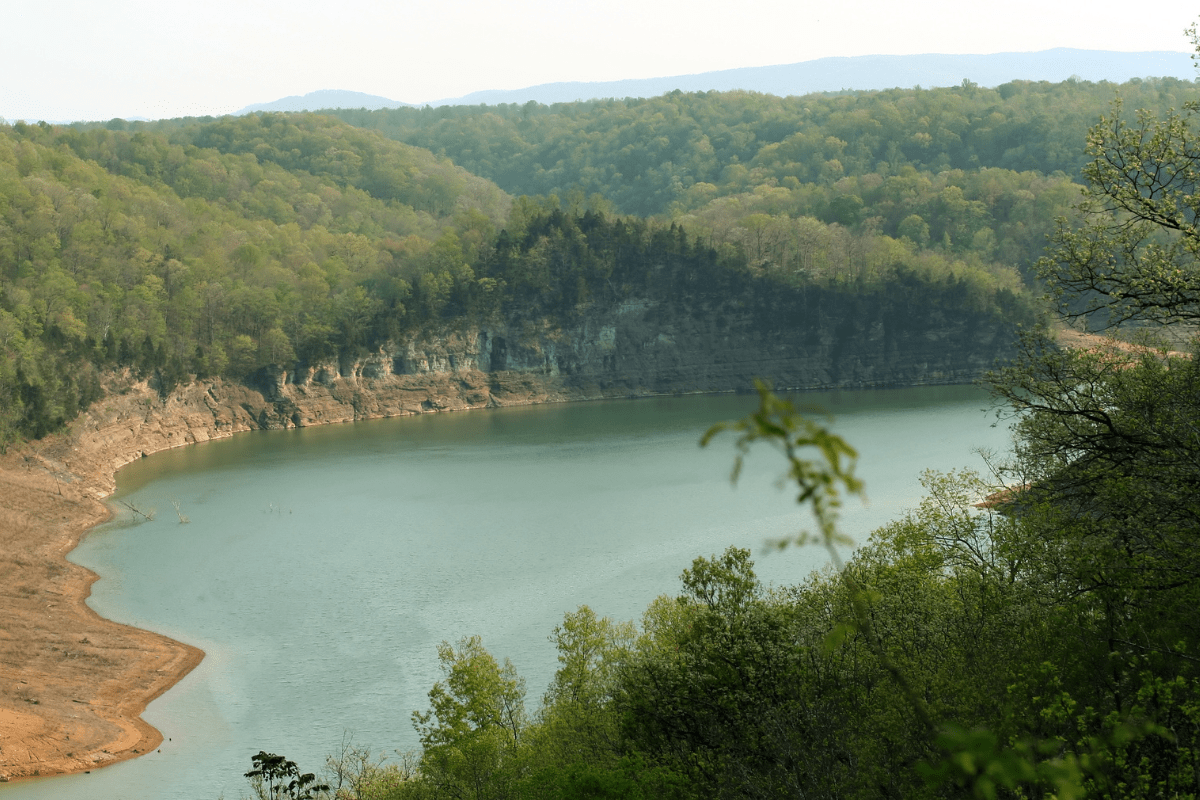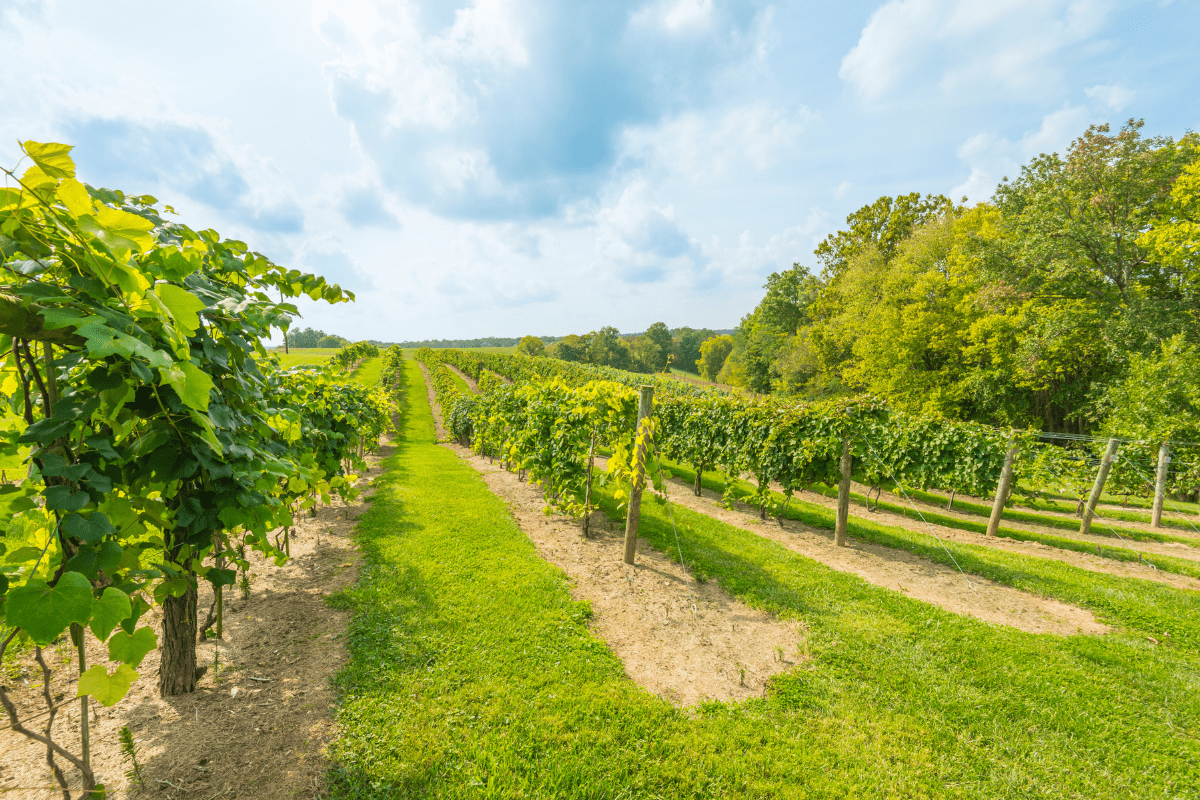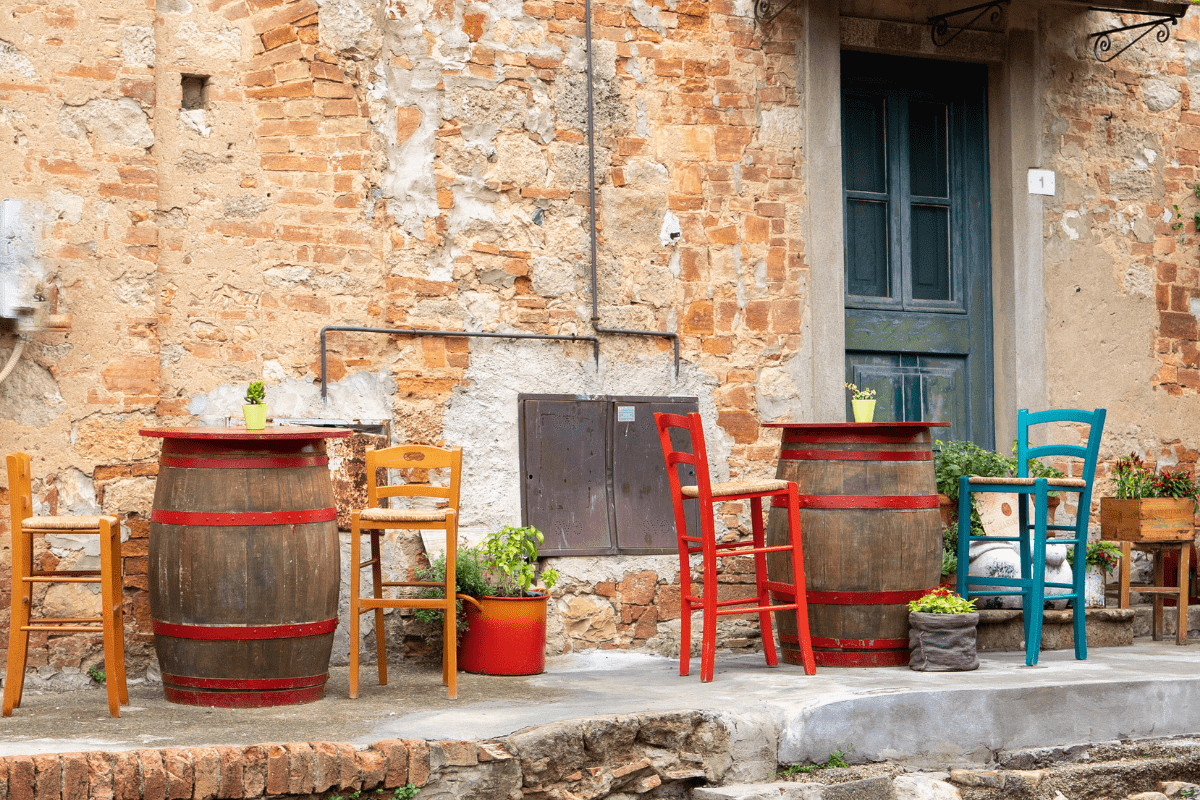Kentucky may be famous for bourbon, bluegrass, and the Derby, but the Bluegrass State's true treasures lie far from the tourist trail. While 80 million visitors flock to the state's major attractions each year, savvy travelers are discovering an entirely different Kentucky where moonbows dance over waterfalls, underground boat tours navigate impossibly blue water, and clothing-optional swimming holes remain local secrets.
Nature's Hidden Sanctuaries That Google Maps Won't Show You
Let's be honest: Mammoth Cave is incredible, but fighting through tour groups while wearing a mandatory headlamp isn't everyone's idea of communion with nature. Kentucky's real natural wonders require a bit more effort to reach, which naturally filters out the selfie-stick crowd.
The Waterfall You Can Only Reach by Kayak
Mystery Falls on Lake Cumberland might be Kentucky's best-kept secret, and I mean that literally. This 54-foot cascade was only discovered recently through aerial mapping, and here's the kicker: you can't walk to it. The only way to experience Mystery Falls is by launching from Twyford Point boat ramp (GPS coordinates: 36.824024, -84.938334) and paddling into a hidden cove where you can swim right beneath the thundering water.
I stumbled upon this place purely by accident last summer when my GPS died and I took a wrong turn in my rental kayak. There's something magical about floating up to a waterfall that doesn't have a single trail, parking lot, or informational plaque. Just you, the water, and maybe a confused bass wondering what you're doing in his living room.
Chasing Moonbows Like a Slightly Unhinged Person
Cumberland Falls hosts one of only two predictable moonbows on Earth, and before you ask, yes, a moonbow is exactly what it sounds like: a rainbow created by moonlight. While daytime visitors crowd the main overlook snapping photos of the "Niagara of the South," the real magic happens after dark during the full moon.
Here's what the tourism brochures won't tell you about moonbow viewing:
- Winter months produce the brightest lunar rainbows
- Cameras capture colors your eyes can't see
- The main overlook gets surprisingly crowded
- Eagle Falls Trail offers better views
- Star Gap Arch frames the phenomenon perfectly
Time your visit two to three days around each full moon, and bring a tripod unless you want your photos to look like abstract art. The park stays open until midnight during moonbow nights, though honestly, the later you arrive, the more likely you'll have the place to yourself.
Swimming Holes and Secret Falls
Eastern Kentucky's Bad Branch Falls protects 2,639 acres of rare plants and animals, including the state's only nesting pair of common ravens. The 60-foot waterfall requires navigating unmarked paths and rock scrambles, which explains why you'll rarely encounter another soul. Think of it as nature's own velvet rope.
For those seeking a different kind of natural experience, Gabe's Branch Swimming Hole in Harlan County has been a clothing-optional retreat for decades. Follow Abner Branch Road for 1.2 miles until it turns to gravel, then look for steps leading down to the swimming area. The water stays around eight to ten feet deep, perfect for cooling off after realizing you've been hiking in Kentucky humidity.
Museums So Weird They Make Perfect Sense
Kentucky's approach to museums can be summed up as "if you're going to do something, do it weird." These aren't your typical natural history museums with dusty dioramas and school field trips.
A House Full of Ventriloquist Dummies (What Could Go Wrong?)
The Vent Haven Museum in Fort Mitchell houses over 1,100 ventriloquist dummies from 20 countries, making it the world's only museum dedicated to the art of making wooden people talk. Tours run May through September by appointment only, and yes, it's exactly as creepy as you're imagining.
The guided tours cost fifteen dollars as a suggested donation, and the guides genuinely love sharing stories about individual dummies. Some have performed for presidents, others have mysterious origins, and at least one allegedly moves on its own (though that might just be marketing). The annual July ventriloquist convention transforms this already surreal experience into something that defies description.
Bigfoot, UFOs, and Other Reasonable Topics
Hidden in the basement of Somerset's Carnegie Community Arts Center, the International Paranormal Museum celebrates everything that goes bump in the night. The collection includes Bigfoot footprint casts found in Kentucky, UFO artifacts from the famous 1955 Kelly-Hopkinsville encounter, and enough paranormal evidence to make Mulder and Scully argue for hours.
The passionate staff will happily share local ghost stories while selling you "Beasts of the Bluegrass" merchandise. It's delightfully weird, refreshingly unpretentious, and surprisingly educational if you're into that sort of thing.
Where Snake Milking Is a Spectator Sport
The Kentucky Reptile Zoo in Slade produces more snake venom than anywhere else in the United States, housing 1,700 snakes in what's essentially a working research facility with visiting hours. The daily venom extraction demonstrations at 1 PM (except Tuesdays) let you watch handlers milk cobras and rattlesnakes with their bare hands.
This isn't some sanitized zoo experience. You're watching real researchers collect venom that creates life-saving antivenoms distributed worldwide. Call ahead to confirm extraction times because, as they'll remind you, this is actual science happening in real-time, not a scheduled show.
Culinary Treasures That Locals Pretend Don't Exist
Kentucky's food scene extends far beyond the bourbon trail, though finding these hidden gems often requires directions that sound like treasure maps.
The Catfish Joint Down That Gravel Road
Harper's Catfish in Scottsville has served the state's best fried catfish for over 30 years from a location that seems specifically designed to discourage tourists. Take Old Gallatin Road until you hit gravel, then keep going until you think you're lost. The unmarked building at 3085 Old Gallatin Road is cash-only and worth every confusing turn.
The portions are enormous, the prices are stuck in 1995, and the catfish is so good that locals drive an hour each way just for dinner. They also serve frog legs, which I mention only because where else are you going to try them?
Country Ham Without the Tourist Markup
For authentic country ham, bypass the gift shops and head straight to Finchville Farms, where the Robertson family has been sugar-curing hams without nitrates since 1947. Their Kentucky State Fair Grand Champion hams age naturally for a full year, developing a complexity that makes grocery store ham taste like salty cardboard.
Call ahead to arrange a visit and try their famous "biscuit slices," which are thin cuts perfect for traditional Kentucky breakfasts. Warning: once you taste real country ham, you'll understand why Kentuckians get personally offended by honey-baked imposters.
Moonshine That's Actually Worth Drinking
The moonshine renaissance lives strongest away from the main bourbon trail. Neeley Family Distillery in Sparta uses their great-great-grandfather's 150-year-old yeast strain from 1898, and each bottle is hand-numbered by an actual family member, not some marketing intern.
In eastern Kentucky's Whitesburg, Kentucky Mist Moonshine packs up to a pound of real fruit into each bottle. Unlike the tourist-trap moonshine in Gatlinburg that tastes like grain alcohol mixed with Jolly Ranchers, this stuff actually resembles something your bootlegging ancestors might have made.
Essential moonshine trail stops include:
- Neeley Family Distillery (historical yeast strain)
- Kentucky Mist (fruit-forward flavors)
- Douglass Loop Farmers Market (Saturdays only)
- Local distilleries avoiding bourbon crowds
- Anywhere locals actually drink
Small Towns Where GPS Goes to Die
Kentucky's small towns offer something increasingly rare: authentic communities where locals outnumber tourists and Main Street businesses actually survive.
Augusta: Population 1,000 and Perfect
Augusta has preserved its 1797 architecture along the Ohio River, where a ferry has operated continuously since 1798. That's not a typo; this ferry has been running longer than Kentucky has been a state. The town moves at river speed, which is to say barely at all, and that's entirely the point.
Time your visit for the annual Art in the Garden festival, though any season rewards visitors with vineyard views and the genuine pace of river town life. The local restaurants don't have websites because why would they need them? Everyone already knows where they are.
Rabbit Hash: Yes, That's Really the Name
With fewer than 100 residents centered around an 1831 general store, Rabbit Hash takes "small town" to its logical extreme. The general store serves as post office, community center, and informal government seat. They've elected dogs as mayor since 1998, which honestly makes more sense than most political decisions.
Stay overnight at the Old Hashienda, a rustic inn that perfectly captures Kentucky's quirky charm. Fair warning: the town's entire commercial district is basically one building, so adjust your expectations accordingly.
Berea: Where Craftspeople Actually Make Things
Berea earned UNESCO recognition for its century-old craft tradition, and unlike most "artisan" destinations, people here actually make stuff. The Kentucky Artisan Center showcases over 850 artists across 20,000 square feet with free admission daily from 9 AM to 6 PM.
Every Saturday from 10:30 AM to 3:30 PM, artisans demonstrate their techniques in person. This isn't some Colonial Williamsburg situation with costumes and fake accents; these are working artists who happen to let you watch. The downtown studios sell everything from handwoven baskets to bourbon barrel furniture, all made by people who can explain exactly how they did it.
Adventures That Could Only Happen Here
Some experiences are so inherently Kentucky that trying them anywhere else would miss the point entirely.
Zip-Lining Underground Because Why Not
The Louisville Mega Cavern puts the world's only underground zip line course beneath the city, where six lines soar 100 feet above the cavern floor. The constant 58-degree temperature means you can zip line in January wearing shorts, though I don't recommend it.
This former limestone mine turned adventure park also stores valuable goods for businesses, creating the surreal experience of flying over someone's inventory. It's simultaneously the most Kentucky and least Kentucky thing you can do, which somehow makes perfect sense.
Elk Watching in Appalachia
Eastern Kentucky hosts the continent's largest elk herd east of the Rockies, with over 10,000 animals reintroduced since 1997. Book guided tours from Prestonsburg during September and October rutting season when bulls bugle across mountain valleys like something from a nature documentary.
Tours run $25 to $40 per person, and the mountain setting provides photography opportunities impossible in western elk habitat. Pro tip: the early morning golden hour tours mean waking up at an ungodly hour, but the photos will make your Instagram followers think you traveled to Yellowstone.
Uniquely Kentucky Experiences Worth the Drive
At Kentucky Castle in Versailles (pronounced ver-SAILS here, don't be fancy), bourbon barrel painting workshops let you create art on authentic barrels while learning production secrets. The workshops cost $85 to $120, which sounds expensive until you realize you're literally painting on a piece of Kentucky history.
Throughout the state, you can participate in traditional "sipping medicine" workshops, where locals teach you to mix bourbon with honey using recipes their grandparents swore cured everything from sore throats to broken hearts. The medical claims are dubious, but the bourbon is real.
Planning Your Escape From Tourist Kentucky
Successfully exploring hidden Kentucky requires abandoning most traditional travel planning wisdom.
When to Visit (Spoiler: Not During Derby)
Spring brings wildflowers and moderate temperatures perfect for hiking to hidden waterfalls. Fall offers peak foliage and elk rutting season, plus ideal weather for exploring small towns. Winter provides the brightest moonbows and frozen waterfalls, with the bonus of absolutely no crowds anywhere.
Summer is hot, humid, and full of people who had the same idea as you. Plan accordingly.
Budget Reality Check
Most attractions cost between $10 and $15 per person, though many natural sites remain free. Small-town restaurants typically run $5 to $15 for portions that could feed a small family. Guided experiences range from $25 to $120 depending on how specialized they are.
Book accommodations early only for fall weekends; otherwise, Kentucky's hidden gems rarely require advance reservations. That's kind of their whole appeal.
Navigation and Survival Tips
Download offline maps because cell service disappears faster than bourbon at a tailgate. Print actual paper directions like it's 1999. Join local Facebook groups for real-time updates on conditions and access.
Most importantly, talk to locals. Kentucky hospitality isn't just marketing; people genuinely enjoy sharing their secret spots with visitors who seem respectful and interested. Start conversations with "I heard about this place…" and watch the recommendations flow.
Why Kentucky's Secrets Matter More Than Its Attractions
These hidden gems represent more than just alternative tourist destinations. In a world where 67% of travelers actively seek less crowded experiences, Kentucky's lesser-known treasures offer something increasingly rare: genuine discovery.
Whether you're swimming beneath a waterfall accessible only by kayak, watching someone milk a deadly snake, or learning to make moonshine from someone whose family has been definitely-not-making-it-illegally for generations, these experiences create the stories that matter. The overcrowded bourbon tours and Derby parties will always exist for those who want them. But Kentucky's real character lives in the places that don't advertise, don't have gift shops, and definitely don't have parking lots.
Pack your sense of adventure, embrace getting lost at least once, and discover why Kentucky's greatest treasures have always been the ones nobody talks about. The state's 120 counties each hide their own secrets, from clothing-optional swimming holes to underground boat tours through impossibly blue water. The best part? This list barely scratches the surface. Kentucky keeps its secrets well, but it shares them generously with anyone willing to venture beyond the guidebook.





